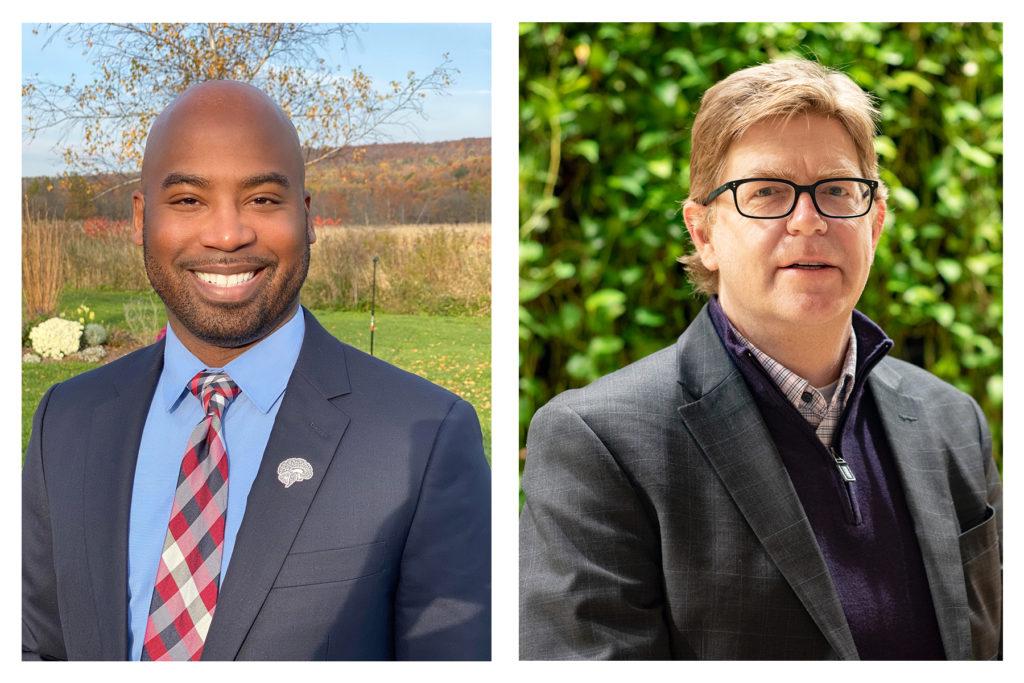Two professors were elected fellows of a nationally recognized science research non-profit honoring scientific experts’ advances in their fields.
Nathan Smith, an assistant professor of pediatrics, and Christopher Cahill, the chair of the chemistry department, joined the American Association for the Advancement of Science Honorary Fellows late last month. They said membership in the AAAS will create opportunities for them to network with a national coalition of accomplished researchers and receive international attention for their career achievements.
Smith’s research targets observing how neuromodulators, chemicals like dopamine that regulate nerve cell populations, interact with astrocytes – star-shaped non-nerve cells – to deter disease progression in the central nervous system. Cahill’s research focuses on studying how nuclear energy and waste production can use F-elements – chemical substances located at the bottom of the periodic table.
Interim University President Mark Wrighton – who himself was elected to the AAAS in 1986 – congratulated Cahill and Smith’s appointments as AAAS Fellows at a Board of Trustees meeting earlier this month, saying the honor recognizes them as “outstanding” contributors to science.
“We have a distinguished and key faculty leadership that is really making important contributions in their areas of activity,” he said at the Board meeting.
The AAAS Honorary Fellows are a group of scientists and engineers who are annually honored for their achievements in research, teaching and interpreting scientific information to the public, according to the AAAS website.
Smith said he is honored to be an AAAS Fellow because his experience as a Black professional in medicine can serve as an example for others who come from similar backgrounds and motivate them to not give up on their scientific research journeys.
He said he will share information about the benefits of the AAAS as a spokesperson to other scientists from minority backgrounds in hopes of recruiting more members of color.
Smith said he hopes to discuss and disseminate his research on nerve cell interactions with other neuroscience experts to treat diseases in the central nervous system while advocating for more diversity, equity and inclusion within the AAAS.
He said the fellowship comes with access to a network of scientific experts within the AAAS community and the prestige that the District-based organization carries as a national center for scientific research with notable fellows like Thomas Edison.
“Diversity powers innovation, and in order for science to continue to move forward, we need a more diverse science workforce,” he said.
The AAAS has also recognized University faculty members like Leo Chalupa, a professor of pharmacology, Bernard Wood, a professor of human origins, and Chryssa Kouveliotou, the chair of the physics department, as fellows in the past.
Cahill said the title as an AAAS Fellow helps him meet and engage with other members of the scientific community if he ever needs advice for future research projects and proposals.
He said he hopes to get more involved in science policy like nuclear energy and waste production, which he’s developed an interest for in the past decade. He said while the fellowship won’t directly impact his research with benefits like grant funding, he hopes to continue attracting more graduate and undergraduate researchers to help out in light of their contributions to the studies that have helped him garner AAAS recognition.
“I want to be sort of crystal clear on that – pun intended there because I’m a crystallographer – but this is really as much about the student accomplishments as it is mine,” he said.
Keith Crandall – a member of the 2013 class of AAAS Fellows and the director of the Computational Biology Institute, a GW research institution that combines computer use with biology and medicine – said scientific experts in the AAAS should recognize other “extraordinary” research projects that fellows complete because research funding overlooks the researchers’ efforts for the studies, focusing more on the type of content they include.
He said AAAS fellowship means one’s research has received international attention.
“It’s always nice to have somebody pat you on the back and say ‘Good job,’ and that’s what it is,” Crandall said. “It’s an emotional benefit more than anything.”
Michael Plesniak, the chair of the mechanical and aerospace engineering department and an AAAS Fellow, said becoming a fellow provides a faculty member with more “visibility” as a leader in the AAAS community and a greater opportunity to shape scientific research agenda in the future. Plesniak said the AAAS Fellow title reflects the contributions of research teams that include graduate and undergraduate student researchers and staff in addition to the main professors who lead the research projects.
“I am honored to be part of an impressive group of AAAS Fellows at GW that includes President Wrighton, and I expect that we will see many more deserving GW faculty being recognized in the coming years,” he said in an email.







